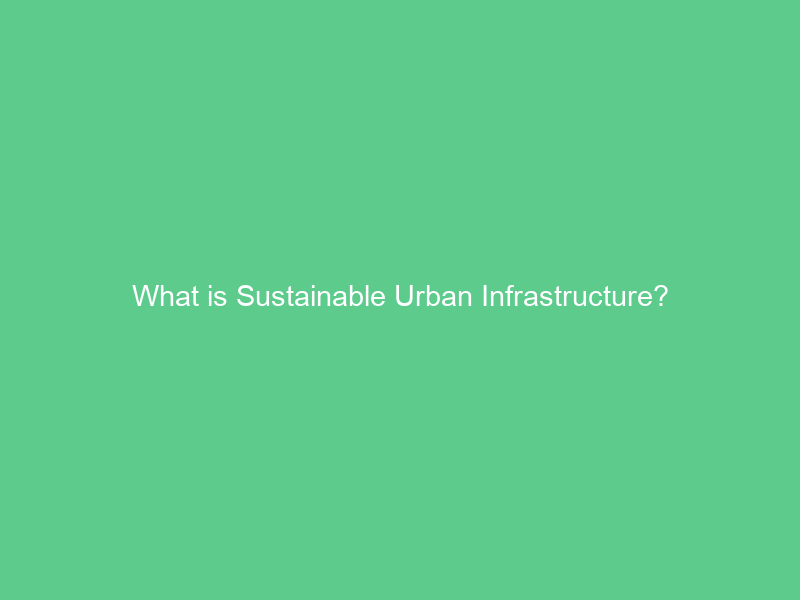Sustainable urban infrastructure refers to infrastructure designed and constructed in such a way as to achieve economic, social and environmental (including climate resilience) sustainability over its lifecycle. This may involve nature-based solutions as well as conventionally built ones.
Sustainable cities are integrally interwoven with rural constituencies, so it is vital that infrastructure decision-makers consider their needs and opportunities when making infrastructure decisions. Doing so requires understanding the complex interactions between infrastructure and its users.
Greener and more efficient
Sustainable practices reduce energy use, waste generation and pollution while improving air quality and biodiversity. Furthermore, sustainable practices enable cities to become less dependent on fossil fuels while better adapting to climate change.
Green infrastructure includes parks, green roofs, wetlands and permeable paving that incorporate plants, soils and natural elements into the built environment. They help prevent flooding while improving air and water quality as well as mitigating urban heat island effects – not to mention providing habitats for wildlife.
Many of these technologies also cost significantly less than conventional infrastructure. To make sustainable urban infrastructure a reality, governments should invest in education and awareness programs and incorporate sustainable development strategies into city planning and development processes. Furthermore, private organizations should support sustainability initiatives with projects having measurable impacts that benefit everyone in their community – thus making sustainable urban infrastructure an asset to all involved parties.
Resilient to disasters
Natural disasters pose an immediate danger to urban development, with devastating economic losses, endangered human lives and potential disruption of sustainable urban development goals all potential risks that must be considered by any successful infrastructure plan. To minimise these risks and ensure its resilience is realized.
Green infrastructure investments can protect cities against the effects of climate change by improving water, air, biodiversity and energy quality; cutting energy costs while creating valuable co-benefits for residents and visitors. They may even help lower risk premiums for insurers and investors.
Community-led resilience projects ensure infrastructure is designed and constructed according to local needs, creating robust systems more likely to withstand disasters. At the center of all this lies Making Cities Resilient 2030 initiative; an international multi-stakeholder network designed to speed implementation of Sendai Framework for Disaster Risk Reduction locally.
Better for the environment
Sustainable urban infrastructure uses nature as the cornerstone for providing infrastructure services, from air and water purification to climate regulation and carbon sequestration. Building with nature often works out more economically than using conventional engineering solutions.
Cities around the world are adopting environmentally sustainable infrastructure to reduce their environmental impact. Stockholm stands out as an environmentally sustainable city by employing renewable sources as part of their electricity grid system.
Urban sustainability measures can also contribute to an improvement of the economy by creating jobs, reducing pollution levels, and increasing public health outcomes. Private organizations are joining in support these initiatives through innovative financing mechanisms such as social impact bonds – where private investors fund projects with measurable economic and ecological results.
Better for the economy
As more and more people move into cities and towns, it’s becoming increasingly crucial that our infrastructure be sustainable. According to Sustainable Infrastructure Definition: Sustainable infrastructure “refers to projects planned, designed, constructed, operated, decommissioned in such a way as to ensure economic, financial, social (including climate resilience ), environmental and institutional sustainability across their life cycles.”
Sustainable urban systems not only contribute positively to our environment, they’re also more economical and energy efficient than traditional infrastructure, reducing energy and water consumption as well as carbon emissions.
Cities around the world are implementing their own sustainability programs. From New York’s carbon challenge and electric vehicle charging stations to Los Angeles’ public transit expansion and bike paths and Boston’s waste management guidelines – each city’s efforts towards becoming more eco-friendly offer proof that change is possible.
Better for citizens
Cities need to provide citizens with economic employment, safe living environments, and recreational activities – and sustainable urban infrastructure makes this possible while simultaneously reducing energy use, waste production and pollution levels.
By adopting greener methods of transport, cities can reduce traffic congestion and emissions while improving air quality. Furthermore, cities may promote alternative modes of getting around such as cycling and public transit services to promote healthier alternatives for getting around.
To achieve sustainability, all sectors of the economy must participate, which is why it is so vitally important for people to have a comprehensive knowledge base on all components of sustainability and urban planning. Educational institutions and seminars provide this essential education, which allows people to make more informed decisions when building or investing in sustainable infrastructure.

